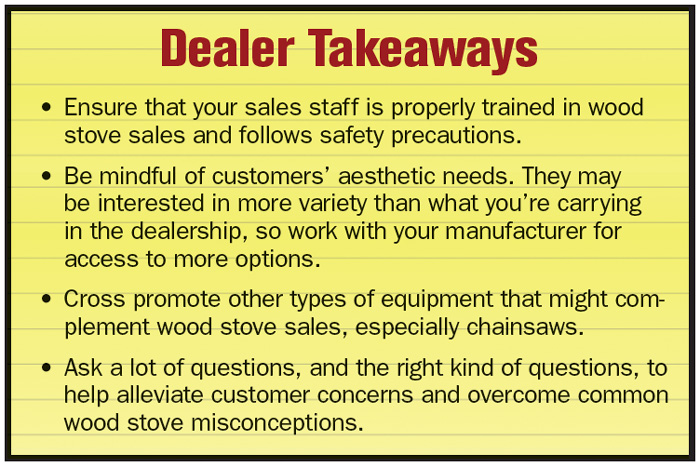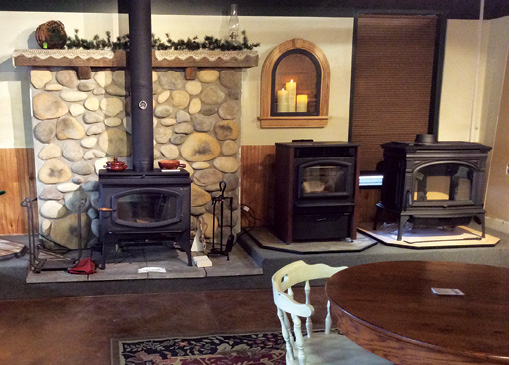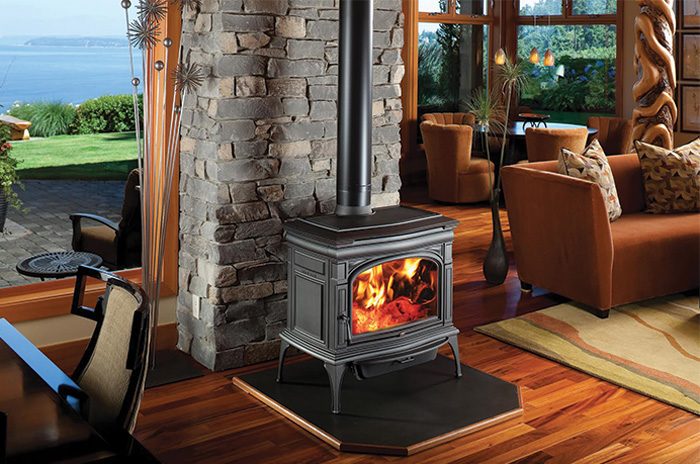Skyrocketing propane costs last year sent wood and pellet stoves into the spotlight and boosted sales for this niche product market. But with this year’s fuel prices stabilizing and even dropping, are wood and pellet stoves a good investment for your dealership?
Aesthetics are important to rural lifestylers when choosing the right wood stove for their home. The above image shows the Cape Cod model from Lopi.
Rural Lifestyle Dealer talked with several dealers who have seen things heat up in wood stove sales and one who maintains their wood stove supply in spite of lukewarm sales. These specialty products may go hand in hand with the needs of your self-sufficient customer base, but can your sales staff quickly adapt their expertise to this product line? Will you be able to offer installation and service? These are all questions to consider before investing in or expanding your wood stove selection at your dealership.
Service Helps Sales
Tim Boals of Ferguson Lawn Equipment in Traverse City, Mich., bought his dealership 2 months ago and has already seen the benefits of offering wood stoves in addition to equipment lines from Toro, Stihl, Echo, Exmark and others.
“We’re having a great year coming off of last year’s hard winter. The price of propane being so high heightened interest in this category last year, but even with prices down, we’re seeing sales 45 days sooner than typical,” says Boals. Ferguson’s geographic location near the Great Lakes means more customers have a need for supplemental heat, but that’s not the only reason they’ve seen sales skyrocket.
“The volume is unprecedented. Installations are hard to keep up with. We’re out as much as 40 days, but people are willing to wait because we have a wonderful installation team,” says Boals. “We have a very diverse customer base, but one thing they have in common is they’re all looking for a solution. We’re here to be a solution provider. Whether they’re paying too much for heat or can’t live in a certain part of the house that’s not comfortable in winter time, we can provide solutions. Customers appreciate that kind of service.”
Wood stoves are potentially dangerous if not installed and used properly, so service before and after the sale is even more important.
“Finding a reliable source of information and installation expertise provides a great sense of relief to our customers. Once they get to know us and see how knowledgeable we are, they feel more comfortable. We go out to the customer’s home, see where they’d like their fireplace, take measurements and make sure we have room. We provide a quote to give back to them the next day. Our installers know what they’re getting into when they show up at the home, so we’re time efficient,” Boals says.
Appreciating Aesthetic Appeal
One factor that sets wood stoves apart from most other offerings from equipment dealers is aesthetics. A rural lifestyler may not care how stylish their post-hole digger is, but they want their wood stove to reflect their personal taste in their home.
Ferguson’s sells a diverse product line, with even sales across all models.

Ferguson Lawn Equipment offers an experienced installation team that follows safety guidelines for installations. The dealership is located in Traverse City, Mich.
“We sell wood stove models from Vermont Castings, Avalon, Lopi, Hearthstone, Fireplace Xtrordinair and Jøtul. It’s really all about personal taste. All are really good brands. They all heat well. It’s all a matter of looks,” says Boals. “Aesthetics matter to wood stove customers. They all have their own distinct look in the marketplace. There are a lot of ways to deliver fire into a home and it’s very customized to where it will be in their home, etc.”
Ferguson’s focuses more on wood burners than pellet stoves because wood is readily available in their region. The dealership’s pellet stove offering is small and features upper-end models from Leyden, Pioneer, AGP, Arbor, Astoria, Heritage and Manchester.
One benefit to carrying a wide product line is that customers are more likely to invest in a wood stove if they can find a model that matches their preference.
In addition to aesthetic concerns, Boals addresses another common misconception about wood stoves. “We try to ask the right questions to wring out misconceptions. We make sure people really want what they say they want. The biggest concern people have is buying too large of a unit and it will heat them out of the house. You don’t have to run these things at full bore all the time, and we can educate customers on the appropriate way to use them,” Boals says.
Spreading Sales
Ferguson’s has backed off on advertising their wood stoves in traditional ways and rely instead on word of mouth recommendations. “We have customers who come in off a builder reference or from their neighbor’s advice or other such connections. We also have repeat customers, who come in after making a lawn equipment purchase in the summer. They know we sell wood stoves and they have had a good experience with us.
“It’s very gratifying to get calls from people who can enjoy parts of their house that they’ve never occupied before. People can create zone heating in their home and simply heat where they live, meaning cost savings and happy customers,” says Boals. “It’s all about the people. We have a team that customers like and that exceeds their expectations.”
Increasing Winter Sales
Selling wood stoves helps Martin’s Outdoor Power Equipment, Seneca Falls and Geneva, N.Y., increase stagnant sales in the winter months. Now, business has been so strong they are considering creating a separate business. Martin’s carries wood stove models from Lopi and Avalon and outdoor equipment from Briggs & Stratton, Woods and Yanmar.

“We started the business in 1993 and didn’t start selling wood stoves until 2007, initially with outdoor boiler units and then indoor wood stoves in 2008,” says Jason Martin, owner. “It was natural because our family owned one personally and we saw an opportunity for increased sales 3 or 4 months out of the year to add some revenue. Before, we didn’t have profits coming in during the winter. We needed something to fill up those slow times. Then once we got into the outdoor wood burner boiler business, we had people asking for indoor stoves, so we added them.
“We’re having a strong year, probably due to last year’s colder weather. Sales in 2014 were still ahead of 2013, even though it’s softened just a bit this past fall as propane has stabilized,” says Martin. “Our biggest challenge is training employees well enough to do hearth sales in the fall and outdoor power sales in the spring. That’s why we’ve decided to essentially make two businesses out of it, Martin’s Outdoor Power Equipment and Martin’s Fireplace, so there’s less cross over in staff.”
Safety Improves Sales
The staff at Martin’s offers a full range of installation and maintenance services, are certified through the National Fireplace Institute and also provide chimney sweeping services.
“It’s important to people, and to our business, that we have the right certifications and know how to get it done safely. For example, most people don’t realize they still need to have their flue cleaned once a year if they have a pellet stove,” says Martin. “When we install the stove, our tech goes over safe operations and proper maintenance with the customer. We cover everything between when the stove is installed to when the first fire is lit. These are important things that not only keep our customers safe, but help us improve sales when customers feel more at ease. We educate about safety precautions throughout the entire process.”
“We’ve definitely had success with cross promotion…”
Martin emphasizes the importance of a properly trained sales staff. “Make sure you have the staff cross trained and taking an interest in both lines of work. When you sell both equipment and wood stoves, it’s two vastly different types of work. One type you’re working on motors and grease, etc., and on the other side you’re going into someone’s house and need to be neat and clean and doing nice finish work around the wood stove. Ideally, you’ll find someone that specializes in one or the other or has a broad talent base. The rural lifestyle customer base makes sense for wood stoves, but the employee base is more of a challenge,” says Martin.
Cross Promoting Equipment
One major benefit of offering wood stoves at their equipment dealership is Martin’s ability to cross promote equipment that complements wood stove sales.
“We’ve definitely had success with cross promotion. For example, when someone purchases a wood stove, we’ll encourage them to get a good chainsaw if they’ve got wooded acreage. And anyone who’s purchasing a wood stove is more than likely a homeowner with a yard to maintain. If they’re burning wood, they’ve likely got trees, and if they’ve got trees, they’ve got yard needs. We try to take care of all of their needs if possible,” says Martin. He also helps increase sales of higher priced models by offering financing options.

Ferguson Lawn Equipment’s showroom displays a wide variety of stoves in varying styles, giving customers more choices to match their personal taste.

The wood stove showroom at Martin Outdoor Power Equipment is staged with the touches of home, such as area rugs and décor, to help a customer visualize how a stove might look in their own home.
“We don’t sell cheap product lines like some customers might find at mass merchants. They’re going to spend a little more money to get a better quality product and we try to help by offering financing. The majority of customers don’t use this offer, however. Many are rolling it in with a home equity line of credit,” Martin says.
The Right Questions Deliver Results
Wood stoves may be a new product for both your sales teams and your customers. Know the right questions to ask to help customers make the best purchase. Here are some suggestions based on information from the Hearth, Patio & Barbecue Assn.
1. Where will your hearth product go?
With today’s venting options wood stoves can be installed in many places in the home, even nontraditional locations, such as the kitchen, home office or master bedroom or bath. Creating an outdoor living room is a very popular trend today.
2. Do you have an existing fireplace or stove?
If the customer has an inefficient or seldom used unit, converting to a new hearth product may be simple and affordable.
3. Do you want a wood stove for its cost savings, for its warmth, or both?
Some hearth products are more decorative, while others are extremely efficient and beautiful to watch at the same time. How much heat output does your customer need?
4. How much of your home do you want to heat?
Help your customer determine the right size by asking if the wood stove will be used to heat a single room, living zone or entire house.
5. Which fuels are accessible to you?
Help your customer determine the best options and savings based on their local fuel availability. For instance, wood burning stoves are a great option for those customers who own wooded acreage and those without should perhaps consider wood pellet burning models (some of which can also burn corn).
6. Are you concerned about having heat during power outages?
A benefit of some wood stoves is that they can operate during power outages, when you need the heat the most. (Pellet models are the exception because they require a power source to feed pellets and blow heat.)
7. How much do you want to spend?
Price is always a consideration. Depending on which product lines you’re carrying, prices range from a few hundred to several thousand dollars. Fuel prices are also a factor to consider and vary by region.
Maintaining Sales Interest
Some dealerships have seen significant sales of wood stoves and others say sales are small, but steady. Tim Current, owner of Aldrich Tractor in Verndale, Minn., has seen less than impressive wood stove sales, in spite of his geographic location. Aldrich carries equipment lines from McCormick, Gehl, Vermeer, Bobcat and others.
“Our sales on wood stoves have been down for a while. Around the year 2000, we sold probably 100-150 a year, but now, it’s only a couple a year,” Current says.
A major reason for the sales downturn is the type of stove Aldrich sells, Magnum flex-fuel pellet stoves, which burn both wood pellets and corn.
“When corn prices went real high, sales went down, even though the stoves could burn pellets, too,” Current says. Despite the change in demand, the dealership is keeping the model. The product line offers peripheral sales and also demonstrates good customer service.
“We had so many models sell in years past and people are still using them. Parts sales on them are good and are probably the biggest money maker for us. We also carry wood pellets. People need fuel to run them and we’re here for that,” says Current. “It also brings people in the door that do online searches in our area for pellet stoves. We’ve got one running in the showroom during the winter, too, so people ask a lot of questions.”
Current stresses manufacturer selection before proceeding with wood stove sales. “Make sure you’ve got a good stove. People come in and ask questions about cheaper brand stoves they’ve seen in big box stores, but there’s no service behind it. We have a better product and better service, so they’ll look beyond the dollar amount and often a sale is made,” he says.






Post a comment
Report Abusive Comment